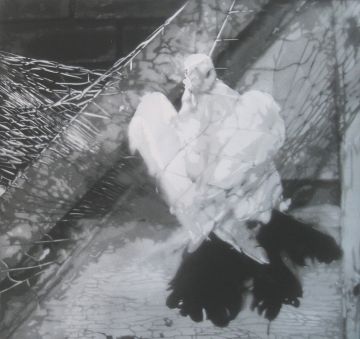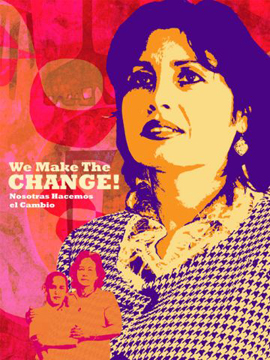
Adam 5-100, "Liberty Bird," 2008. Spray paint on paper. Courtesy White Walls Gallery.
politic
adjective
1. marked by artful prudence, expedience, and shrewdness.
Art and politics have a complex relationship. In the past week, I’ve seen city officials propose the elimination of arts positions, read about Shepard Fairey’s recent arrest possibly being a political stunt performed by Boston police, signed a petition supporting the induction of a Secretary of the Arts into the Presidential cabinet, and sent a letter to my senator expressing my disappointment in her vote against arts funding in the stimulus package. It’s been a long week for heavyweight tangles between art and politics, and the question about one effecting the other is not easily answered.
I asked two local artists living and working in Oakland, California to respond to the current Flash Points question, “How can art effect political change?” Their responses are quoted below.
Like Art:21 Season 1‘s featured artist Margaret Kilgallen, Adam 5-100 spent time in San Francisco and has roots in graffiti. His latest paintings are the result of an intricate and incomparable stencil layering process. Adam 5-100 has worked in the fine art, design, and illustration arenas and was featured on KQED’s Spark series in 2007.
Art has never set the political agenda for a major party, or a minor party, for that matter. It probably never will. The interests of artists have never been that important to the masses until recently when, after 8 years (the Bush debacle), not only artists, but a large segment of the population felt completely voiceless in the operations, actions, agendas, and attitudes of our government. Even then it was not just art, it was everybody. Then Obama shows up and all that pent up energy was released (e.g., Shepard Fairey’s Obama image) — I doubt there was one visual artist in the country who didn’t paint or design Obama’s portrait.
Art is a magical weapon of propaganda. It can’t make people who are entrenched in a certain belief change their minds, but it can propagate the faith of someone who is on the fringes of the targeted agenda. Liberal or Conservative.
If the question was “How can art affect change?” my answer would be a lot longer, and full of metaphors for how culture pulls and pushes, squeaks forward then is dragged begrudgingly back.

Favianna Rodriguez, "We Are the Change," digital image, 2009. Courtesy of the artist.
Favianna Rodriguez is a new media artist and printmaker who was also featured on Spark in 2007. She develops community collaboration and web projects, works with immigrant rights groups, and is currently teaching as part of her residency at the University of Illinois.
As a woman of color artist and first generation American, my art practice serves as a voice for marginalized, disenfranchised people all over the world. In my work, I depict and critique the daily reality of immigrant workers, youth in prison, black and brown kids on the streets that have been left behind by our deteriorating school system.
I view art as a tool for education, agitation, and social critique. Through an artistic practice, it is possible to confront the multitude of images of disempowerment fed to us by mainstream media. Essentially, art can serve as a manifestation of the world we seek to create. It is imperative to understand that we practice art in a time of increased media monopoly. The level of self-censorship in mainstream media leads to one-dimensional coverage of issues that are important to all citizens—the war in Iraq, our dependence on oil, the true costs of “free trade” and globalization (to name a few). In this context, the voice of dissent becomes of even greater importance. We, as political artists living in the most powerful country of the world, have a responsibility to expose the stories that are most censored, and to build ties with the people on the ground who are working for social change. Art alone does not transform the world. Mass movements do. It is the unique collaborations between artists, activists, and people that forge true social change.
As artists, we can also easily be co-opted by corporate America—our art turned into a commodity. Too often, transnational corporations take the message of change, sell it back to us, and behind our backs violate the very principles for which we fight. The reality is that corporate America is responsible for the waste on the planet, the degradation of workers rights across the world, and the devastation of our natural resources. Ultimately, we must elect to fight for the people and for the planet, not for their bottom line. And that is the hardest stance to take. We must BE the change we talk about. Our future depends on it.
Kristin Farr is an artist and Project Supervisor for Arts Education at KQED in San Francisco. She was a featured guest blogger on this site in 2008.



